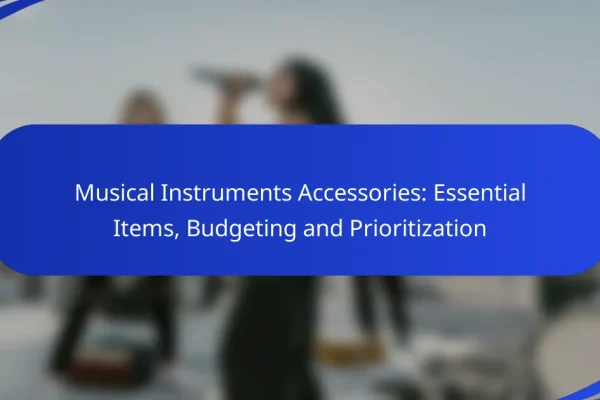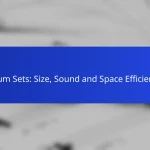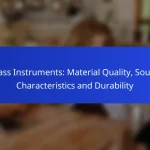What are the average prices of musical instruments in the US?
The average prices of musical instruments in the US vary significantly based on the type and quality of the instrument. Understanding these price ranges can help you budget effectively for your musical needs.
Guitars average $300
Guitars are popular instruments with a wide price range, typically averaging around $300. Entry-level acoustic guitars can be found for as low as $100, while higher-end models may reach $1,000 or more.
When purchasing a guitar, consider factors such as brand reputation, materials used, and whether you prefer acoustic or electric models. It’s often beneficial to try different guitars in-store to find one that feels comfortable and sounds good to you.
Pianos average $3,000
Pianos generally have a higher price point, averaging about $3,000 for a quality instrument. Digital pianos can start around $500, while grand pianos may exceed $10,000 depending on the brand and craftsmanship.
When budgeting for a piano, consider the space you have available, the type of sound you prefer, and whether you want a traditional acoustic or a more portable digital option. Regular maintenance and tuning should also be factored into your overall cost.
Violins average $1,000
Violins typically average around $1,000, though beginner models can be found for less than $200. Higher-quality violins made by renowned luthiers can cost several thousand dollars.
When selecting a violin, pay attention to the craftsmanship, wood quality, and sound projection. Renting a violin can be a good option for beginners, allowing you to explore different sizes and styles before making a purchase.
Drum sets average $500
Drum sets usually average about $500, with entry-level kits available for around $300. Professional-grade drum sets can range from $1,000 to several thousand dollars, depending on the brand and features.
When buying a drum set, consider whether you want an acoustic or electronic kit, as this can significantly affect the price. Additionally, think about the space you have for setup and whether you need extra accessories like cymbals and hardware, which can add to the overall cost.
How to budget for purchasing musical instruments?
Budgeting for musical instruments involves setting a financial limit, identifying essential items, and weighing the benefits of new versus used options. This approach helps ensure that you make informed decisions without overspending.
Set a clear budget limit
Establishing a clear budget limit is crucial for effective financial planning. Determine how much you can afford to spend on musical instruments without straining your finances. A good starting point is to allocate a specific percentage of your monthly income, typically around 5-10% for hobby-related expenses.
Consider all associated costs, including accessories, maintenance, and potential upgrades. This comprehensive view will help you avoid unexpected expenses that can derail your budget.
Prioritize essential instruments
Identifying and prioritizing essential instruments is key to staying within your budget. Focus on the instruments that are necessary for your musical goals, whether for personal enjoyment or professional use. For instance, if you’re a beginner, a basic guitar or keyboard may be more important than advanced models.
Make a list of instruments ranked by importance and allocate your budget accordingly. This strategy ensures that you invest in what truly matters, rather than getting sidetracked by less critical purchases.
Consider used vs. new options
When budgeting for musical instruments, consider the pros and cons of new versus used options. New instruments often come with warranties and the latest technology, but they can be significantly more expensive, sometimes ranging from hundreds to thousands of dollars.
Used instruments, on the other hand, can offer substantial savings, often costing 30-50% less than new ones. However, ensure you check their condition and functionality before purchasing. Platforms like eBay, Craigslist, or local music shops can provide good deals, but always verify the instrument’s quality to avoid future costs.
What financing options are available for musical instruments?
Several financing options exist for purchasing musical instruments, allowing buyers to manage costs effectively. These options include installment payment plans, credit card financing, and rent-to-own programs, each with unique features and considerations.
Installment payment plans
Installment payment plans allow buyers to spread the cost of a musical instrument over several months or years. Typically, a down payment is required, followed by regular payments that may be interest-free or include a small interest rate.
When considering this option, check the total cost, payment frequency, and any fees associated with late payments. For example, a plan might require a 20% down payment and monthly installments over 12 to 24 months.
Credit card financing
Credit card financing enables buyers to purchase musical instruments using their credit cards, often with the flexibility to pay off the balance over time. Many credit cards offer promotional interest rates for new purchases, which can be beneficial if paid off within the promotional period.
However, be mindful of the interest rates that apply after the promotional period ends, as they can be quite high. It’s advisable to pay off the balance before incurring interest, ideally within the first few months.
Rent-to-own programs
Rent-to-own programs allow customers to rent a musical instrument with the option to buy it later. Payments made during the rental period typically contribute toward the purchase price, making it a flexible choice for those who want to try an instrument before committing.
When exploring this option, consider the total cost of renting versus buying outright, as well as the terms of ownership transfer. For instance, a program might allow you to rent for 12 months, with the total rental payments equating to the instrument’s retail price.
What are the best brands for affordable musical instruments?
Some of the best brands for affordable musical instruments include Yamaha, Fender, and Roland. These companies offer a range of quality instruments that cater to various budgets, making them ideal for beginners and seasoned musicians alike.
Yamaha for keyboards
Yamaha is renowned for its wide selection of keyboards that balance quality and affordability. Models like the Yamaha P-45 and PSR-E373 are popular choices, typically priced between $300 and $500, making them accessible for many users.
When selecting a Yamaha keyboard, consider features such as weighted keys, built-in sounds, and connectivity options. Beginners should look for models with educational features, while more advanced players might prioritize sound quality and performance capabilities.
Fender for guitars
Fender offers a variety of guitars that are both affordable and reliable, particularly their Squier line. Prices for Squier guitars generally range from $200 to $500, providing excellent options for new players.
When choosing a Fender guitar, consider the type of music you want to play. Stratocasters are versatile for rock and blues, while Telecasters are great for country and pop. Always try before you buy to ensure comfort and playability.
Roland for electronic drums
Roland is a leading brand in electronic drums, known for their durability and realistic sound. Models like the TD-1K and TD-17KVX are priced between $400 and $1,200, catering to both beginners and intermediate drummers.
When purchasing electronic drums, look for features such as responsive pads, built-in coaching tools, and connectivity for recording. Ensure the kit fits your space and consider investing in a good drum throne and headphones for a complete setup.
How to evaluate the quality of musical instruments?
Evaluating the quality of musical instruments involves assessing their craftsmanship, materials, and overall performance. Key factors include brand reputation, customer feedback, and personal testing to ensure the instrument meets your needs.
Check for brand reputation
Brand reputation plays a significant role in determining the quality of musical instruments. Established brands often have a history of producing reliable and durable products, which can provide peace of mind when making a purchase.
Research brands known for their craftsmanship and customer satisfaction. Look for brands that have been in the industry for several years and are recognized by musicians and educators alike.
Read customer reviews
Customer reviews offer valuable insights into the performance and reliability of musical instruments. Look for reviews on reputable websites and forums where musicians share their experiences.
Pay attention to both positive and negative feedback. Common themes in reviews can highlight specific strengths or weaknesses, helping you make an informed decision. Aim for instruments with a majority of favorable reviews, ideally from users with similar skill levels and styles.
Test play before buying
Testing an instrument before purchase is crucial for evaluating its quality and suitability. Visit local music stores to try out different models and see how they feel and sound in your hands.
When test playing, consider factors like comfort, sound quality, and responsiveness. Take note of how the instrument fits your playing style and whether it meets your expectations. If possible, play alongside other musicians to gauge its performance in a group setting.
What are the costs of maintenance for musical instruments?
The costs of maintenance for musical instruments can vary significantly based on the type of instrument, its condition, and how often it is used. Regular maintenance is essential to keep instruments in good working order, and expenses can range from minor repairs to major overhauls.
String Instruments
String instruments, such as violins and guitars, typically require regular string replacements, which can cost anywhere from $10 to $50 depending on the quality. Additionally, periodic adjustments and repairs, like bridge or fret work, may add another $50 to $200 annually. It’s advisable to have a professional setup at least once a year to ensure optimal playability.
Woodwind Instruments
Woodwind instruments, including clarinets and flutes, often need pad replacements and adjustments, which can cost between $30 and $100 per service. Regular cleaning and maintenance can help prevent more costly repairs, so budgeting around $100 to $300 per year is wise for routine upkeep.
Brass Instruments
Brass instruments, such as trumpets and trombones, require regular cleaning and oiling of valves, which can be done at home or by a professional. Professional servicing may range from $50 to $150, depending on the extent of the work needed. Annual maintenance costs can typically fall between $100 and $250, depending on usage and care.
Piano Maintenance
Pianos require specialized maintenance, including tuning and regulation, which can cost between $100 and $300 per tuning session. It’s recommended to have a piano tuned at least twice a year. Additional repairs, such as action adjustments or voicing, can add to the overall annual maintenance budget, which may range from $200 to $600.






